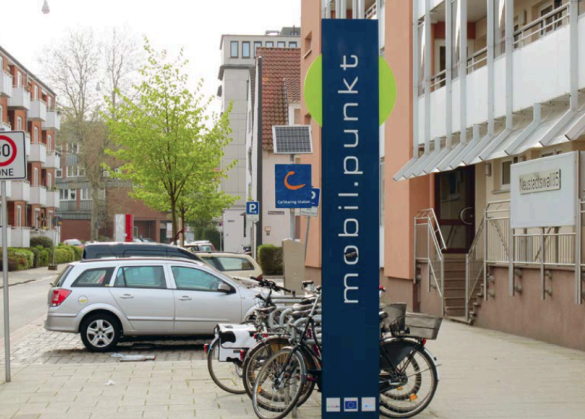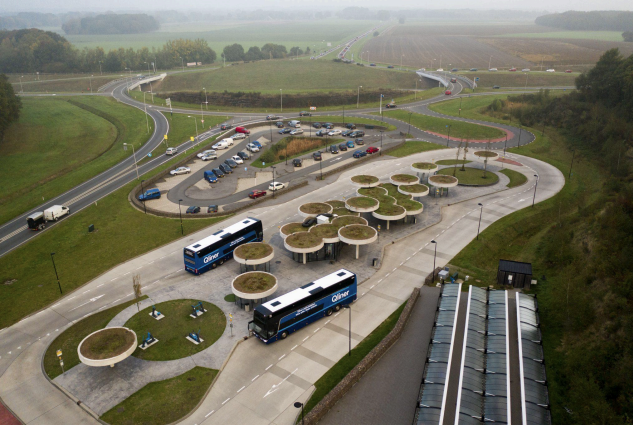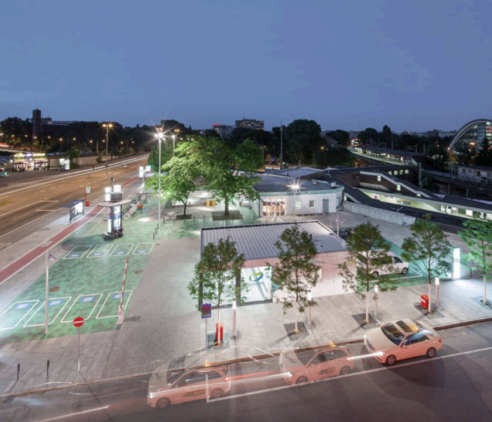How cities are nudging user behaviour to encourage the use of mobility hubs
At Intertraffic Amsterdam 2024 the subject of mobility hubs (a city location where people can access multiples modes of, ideally, shared mobility options), provided one of the most thought-provoking sessions of the entire week. A mobility hubs ‘champion’, and member of the ShareDiMobiHub project, suggesting that, perhaps, a re-think was required. We spoke with the speaker in question, Mpact’s Belgium-based project manager Jelten Baguet, and ShareDiMobiHub’s project leader Eric van Dijk, mobility advisor for the Province of Utrecht, about what constitutes the perfect mobility hub and how best to go about convincing the travelling public to use them.

Intertraffic: Jelten made a really interesting presentation during Intertraffic Amsterdam week, during the “Should I Divorce My Car?” session. Your angle was that there needs to be some reverse engineering done in the mobility hubs space and that the notion of a shared mobility ‘station’ needs a rethink as building and installing more hubs isn’t the complete answer and there’s no one size fits all solution. How, then, can people that live in rural areas benefit from mobility hubs?
Eric van Dijk (EvD): May I answer that one? The Province of Utrecht has been the most competitive region in Europe for a few years now. We're really growing as an attractive place to live and work, but that comes with a lot of pressure on the urban space, so we need some kind of new mobility system. One of the parts of such a new mobility system could be shared mobility, but a decade ago cities such as Oxford, Amsterdam and Rotterdam were flooded with shared low-quality bikes. They were just drifting around everywhere and we don't want that! We want a high quality, urban environment and we are looking for ways to organise this. We see that shared mobility in city centres, the really urban areas of the province, is working but we feel that we’ll miss a lot of opportunities if we keep it to this rather small area. If you live in one city, and you have one provider, you're not going to download another app. If you visit another city twice a year, and use that system, especially if you live in a rural area or the suburbs, then you have doubts installing that first app, because you aren’t going to use that service very often.

We see that shared mobility in city centres, the really urban areas of the province, is working but we feel that we’ll miss a lot of opportunities if we keep it to this rather small area
Intertraffic: So is this another facet of the mobility transition in which changing behaviour, or at least influencing behaviour, plays an intrinsic role?
EvD: Our ambition is to expand shared mobility for the audience. So look at the user perspective, when will they start using shared mobility? And that's when you have an upscaled shared mobility offering, and a good digital access to these systems, and since we don't want these floating bikes, we think the hub part is a core item. You don’t need to reinvent the wheel. Another city must have had similar problems and wants to try to tackle it with us. So that's why we initiated the ShareDiMobiHub project. So together with the city of Amsterdam, but also the Amsterdam Transport Authority, the city of Rotterdam, the City of Leuven and Vestfold and Telemark County in Norway we looking at how we can make this work.

Jelten Baguet (JB): What I find interesting about the ShareDiMobiHub project is that on the one hand, you have the municipalities, the provinces, public and transport authorities who are there to exchange knowledge, but on the other hand, there are some other partners, such as us at Mpact. We’re a non-profit organisation, we have some of our own mobility services and we try to create some buzz around the concept of shared mobility. So we're very active in operations, communication, we organise symposiums such as Shared Mobility Rocks and we do some research as well. Another non-profit is Autodelen.net, who promote car-sharing and shared mobility in Flanders, and by extension, throughout Belgium, and POLIS, the network of European cities and regions. And of course there are universities as well - HAW Hamburg, HU University of Applied Sciences Utrecht and University of Antwerp - which allows for having a knowledge exchange between different kinds of partners, which is part of the DNA of the project. Eric is absolutely right about not needing to reinvent the wheel, because that's the thing you tend to do when you're focusing too much on your own country: there might be interesting experiences from other countries that you might miss.
Intertraffic: That was another of the tenets of your contribution to the panel discussion in that mobility hubs have to be seen as part of an integrated approach to transport and to shared transport in particular
JB: As with every new concept, there was a lot of enthusiasm in the beginning, as though it was going to solve everything. Now, I believe that hubs have to be embedded in something bigger. In the end, it’s about carrots and sticks: mobility hubs are the carrot, something very visually attractive and functional that you give back to society. Reliable public transport, good walking and cycling infrastructure are also carrots. Yet, to exploit the full potential of hubs, you need some stick-like measures as well (or at least measures that are considered as being sticks), such as LEZ, reduced parking availability, and so on. Hubs should thus be part of an integrated approach. SUMPS [Sustainable Urban Mobility Plans] have a lot of potential in this respect, too.
I believe that hubs have to be embedded in something bigger. In the end, it’s about carrots and sticks: mobility hubs are the carrot, something very visually attractive and functional that you give back to society
This integrated approach is actually fundamental for mobility hubs, and is now actually spreading beyond the urban core with smaller and medium-sized cities taking measures to increase shared and sustainable mobility. But it's also expanding regarding the user base. If you look at who's using shared mobility, for instance, in Brussels it's now a larger, more diverse group of people. So you see that this uptake is increasing. This is one of the elements that we have to collaborate on in the project.

Intertraffic: What would constitute the perfect location for a mobility hub and what would be available to the potential user of that perfectly placed hub?
EvD: That's exactly what we are trying to find out! One of the universities that is participating is the University of Applied Sciences in Utrecht. They're developing a tool to spatially analyse the area and see what kinds of people live here, what kind of services are available, and what kind of help is suitable for the area. Because if you look at that, this idea of transitioning to a new mobility system you have to keep in mind that the public envisages a door-to-door service and not to door-to-bus stop or door-to-tram stop. In Utrecht we are seeing a bit of a shift. We have buses and trams in service, but after COVID it's been very hard to keep it economically viable. We're looking to find ways to keep a focus on public transport, but we will also add publicly available transport into the mix. Then you can make a viable alternative, a real option for people to choose their mode of transport because if you're being realistic, people, especially people in certain circumstances, don't have any choice. They can only choose a car and that not only limits their options, but it also limits society in what it can do to make it function as a healthy, economically viable region.
We're looking to find ways to keep a focus on public transport, but we will also add publicly available transport into the mix. Then you can make a viable alternative, a real option for people to choose their mode of transport
JB: I'm pretty much convinced that for cities, and especially the hyper-centres, it works quite well, because you have a business case for car sharing and for micromobility. One of the reasons that it works is that it helps you to keep your city tidy, you don't have these micromobility scooters lying all over the pavements. But if you go further away from the urban areas it becomes more challenging to have hubs on the periphery and in the countryside.
Intertraffic: The dichotomy around mobility hubs is that they are ideal for cities but that cities such as London, Berlin, Paris or Amsterdam are already giant mobility hubs. If you live in a South London suburb such as Croydon, you have access to dozens of bus routes, a tram network, two very well-connected railway stations (East Croydon in particular), a couple of London Overground stations and it’s only a few minutes to the London Underground. And yet a few miles further south you are in the countryside with one bus an hour and a patchy train service.
JB: It is actually useful to have these hubs in cities, because people don't always know that alternatives are available. The more visible the options are, the more people might get interested. Also from a very practical point of view, it's much easier when you get off the Metro, for example, and they find shared bikes or scooters are neatly arranged next to the station, it's much more customer friendly than when you have to start looking around or walk two minutes further. That's something people really don't like to do in order to find a bike - they want to have it next to where they get off. Especially in cities where at night there’s a reduction of public transport services. But in terms of rural locations I couldn't agree more that this is really the place that Mobility as a Service, and mobility hubs in particular, has to be developed.

Intertraffic: The popularity of mobility hubs depends to some extent on the willingness of people to change their travel habits. Is one of the main hurdles that if you tell someone to change their behaviour their response is likely to be “Why should I?” or “What’s in it for me?” Or both!
EvD: This is where the carrot and stick theory comes in. There’s always tension between the societal long-term benefits. How do we combat climate change? What do we do to create a liveable city? All these kinds of abstract issues that people in their everyday lives don't notice. But they will notice after 20 years, and then they look backwards and ask: ‘Why haven't you done something about it?’.
The more visible the options are, the more people might get interested. From a very practical point of view, it's much easier when you get off the Metro and find shared bikes or scooters neatly arranged next to the station
This is why we should keep in mind that no one is envisaging that everyone would immediately change their behaviour and use a new mobility hub the day it opens. There are life-changing moments, people move to the countryside study at university, move in together, separate, get a new job. At that moment, people start rethinking how they arrange their daily lives. We as an authority should have the alternative ready for them. Our job is to find a balance between this long-term benefit everyone accepts and the short-term costs that might look very high but in the end, will seem quite low. The only thing that works is to have showcases to prove that it works in regions such as Utrecht.
Intertraffic: Is that also the case in Belgium?
JB: I would say that everyone agrees that some cities in Belgium have become much nicer places to walk or cycle due to a change of vision in mobility policies. As a result, they have become much healthier, more beautiful places. Car sharing for instance plays a significant role in this: One figure that's cited quite a lot is that one shared car replaces up to 15 privately owned cars, thus freeing up quite a lot of space in urban environments that can be used for living instead of parking. This is something that needs to be widely communicated. Nudging is very important in these discussions. Nudging people to change their behaviour.
**
To view our October 2021 article on Mobility Hubs click HERE.
ABOUT ShareDiMobiHub
Shared and Digital Mobility Hubs (ShareDiMobiHub) aim to improve urban multi-modal accessibility by increasing the introduction and uptake of shared mobility hubs, resulting in a modal shift and changed behaviour towards shared mobility hubs
For more information on the INTERREG North Sea ShareDiMobiHub project, click HERE.
**

Los súper sistemas de transporte de China: cómo la tecnología inteligente está impulsando los metros más avanzados del mundo
04 July 2025

Puerto Chancay: Una Nueva Era de Transporte Inteligente y Ecológico en Latinoamérica
30 May 2025

China’s Super Transit Systems: How Smart Tech is Powering the World’s Most Advanced Subways
18 June 2025
Get up to speed on the mobility industry - our newsletter straight to your inbox!
